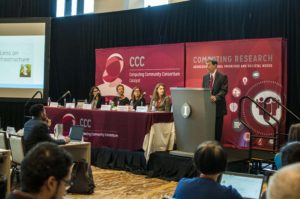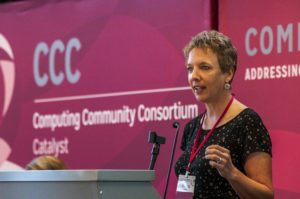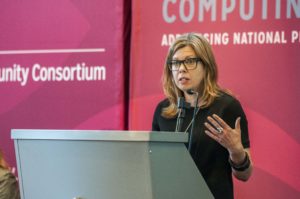
Moderator, Daniel Lopresti, opens the Intelligent Infrastructure for our Cities and Communities Panel
Contributions to this post were provided by CCC Chair Beth Mynatt, CCC Executive Council Member Daniel Lopresti, and the participants from the Intelligent Infrastructure for our Cities and Communities Panel.
Recently the Computing Community Consortium (CCC) posted an overview blog about our recent 2017 Symposium on Addressing National Priorities and Societal Needs. Over the next few weeks, we will highlight each panel session on the blog. This week we are highlighting the Intelligent Infrastructure for Our Cities and Communities Panel.
The plenary speaker, Director of the National Incident Management Systems and Advanced Technologies (NIMSAT) Institute Michael Dunaway from the University of Louisiana at Lafayette, presented on the Blueprint for Current and Future Smart Cities, a talk that is very timely due to a number of recent natural disasters and incidents of mass violence. Dunaway also talked about NIST’s Global Cities Team Challenge and the associated SuperCluster to highlight a blueprint on how smart cities can be formed. Many of the SuperCluster themes overlap with computing research. He stressed to the computer science researchers in the audience the need to build in resilience in their projects so that the projects change depending on unpredictable disasters.

Chandra Krintz, UC Santa Barbara
One of the Intelligent Infrastructure panel members Elizabeth M. Belding, from the University of California, Santa Barbara (UCSB), discussed intelligent infrastructure from a rural lens and commented that we need to do more to increase broadband in rural areas. Another panel member, Chandra Krintz, also from UCSB, looked at intelligent infrastructure from an agriculture perspective and remarked that agriculture is tremendously underserved – we use 80% of our fresh water for agriculture and 30% of our global energy but we lose almost half of what we produce. She recommended data-driven decision support to help farmers improve efficiencies and increase yields. Her approach investigates self-managing data analytics systems that run on-farm, which farmers can use to automate processes and give them actionable insights, while maintaining control over the sharing and ownership of their data.

Jennifer Clark, Georgia Tech
Assistant Professor of City and Regional Planning and Electrical and Systems Engineering Megan Ryerson, from the University of Pennsylvania, was more focused on the user and how we can integrate the user’s perspective in planning smart cities. She brought up the question of whether autonomous vehicles will be safe for pedestrians and cyclists and stressed that we will need pedestrian sensing vehicles and vehicles that predict pedestrian behavior. She also brought up an interesting point that the way large-scale infrastructure investments (e.g., building / expanding airports) are created, by using old urban planning models, don’t take into account the directions we’re heading with smart cities. It is important that we make sure our current infrastructure planning process is ready for intelligent infrastructure. Jennifer Clark, the Director of the Center for Urban Innovation and Associate Director for Smart Cities and Inclusive Innovation from Georgia Tech, discussed how intelligent infrastructure underpins and affects our economy. She remarked that planning for an intelligent infrastructure enabled economy requires interoperability and resilience, expertise and knowledge across disciplinary boundaries, and equity and sustainability.
During the question and answer session, one audience member asked how we can incentivize growth of innovation in rural areas. Belding and Krintz both agreed that the financial investment needs to be there, but noted that we are also missing education. In order to incentive infrastructure innovation in rural areas, we need to create a skilled workforce and encourage young people to use their technology skills for good. Another problem brought up by an audience member was how to change the culture about where people are going to invest. We need to talk to people in different groups and keep the community and NSF in the loop. It is important to continue to have conversations about real world problems like this and connect these important national issues with computing research opportunities.
Stay tuned to the blog next week as we continue to highlight the other session panels from the symposium. See the video from this plenary and panel session here.










Trackbacks /
Pingbacks